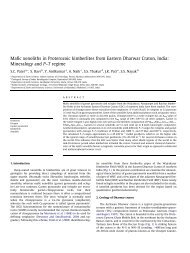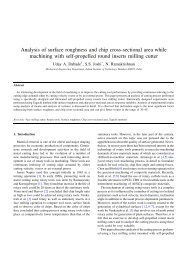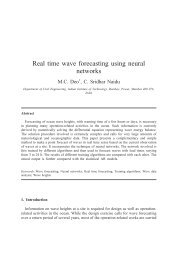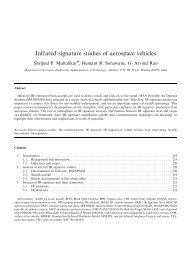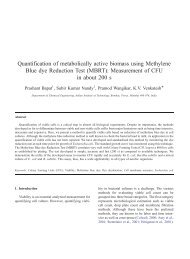A Measurement Study of the Linux TCP/IP Stack Performance and ...
A Measurement Study of the Linux TCP/IP Stack Performance and ...
A Measurement Study of the Linux TCP/IP Stack Performance and ...
Create successful ePaper yourself
Turn your PDF publications into a flip-book with our unique Google optimized e-Paper software.
ility <strong>of</strong> <strong>the</strong> kernels on a single CPU. We would<br />
now like to investigate <strong>the</strong> scalability <strong>of</strong> <strong>the</strong> kernels<br />
on parallel processing hardware. The basic question<br />
that needs to be answered is, if <strong>the</strong> number <strong>of</strong><br />
CPUs increases, does <strong>the</strong> kernel capacity increase<br />
proportionally? We answer this question in <strong>the</strong> case<br />
<strong>of</strong> going from single to dual processors.<br />
We did this by carrying out two types <strong>of</strong> experiments<br />
on <strong>the</strong> Xeon dual processor machine: bulk<br />
data throughput, <strong>and</strong> connection throughput. We<br />
carried out tests with SMP enabled <strong>and</strong> disabled,<br />
<strong>and</strong> observed <strong>the</strong> scale up obtained.<br />
A. Bulk data throughput experiments<br />
Bulk data throughput experiments were done<br />
using iperf; which is a <strong>TCP</strong> traffic generator. The<br />
experiments were run over <strong>the</strong> loopback interface.<br />
The tests were run for a duration <strong>of</strong> 30 seconds<br />
with <strong>the</strong> <strong>TCP</strong> window size set to <strong>the</strong> maximum<br />
<strong>of</strong> 255KB. The buffer size was set to <strong>the</strong> default<br />
value <strong>of</strong> 8KB. Three sets <strong>of</strong> experiments were run<br />
for each kernel: 1) single <strong>TCP</strong> connection, single<br />
processor, 2) single <strong>TCP</strong> connection, dual processor,<br />
3) multiple <strong>TCP</strong> connections, dual processor For<br />
kernel 2.6, an additional experiment with a single<br />
<strong>TCP</strong> connection on dual processor with hyperthreading<br />
disabled was also carried out.<br />
Figure 5 shows <strong>the</strong> results <strong>of</strong> <strong>the</strong> experiments for<br />
one <strong>and</strong> two <strong>TCP</strong> connections. Figure 6 shows <strong>the</strong><br />
full set <strong>of</strong> results with number <strong>of</strong> <strong>TCP</strong> connections<br />
varying from 1 to 12.<br />
First, consider <strong>the</strong> scale up achieved by kernel<br />
2.4, as seen in Figure 5. With a single <strong>TCP</strong> connection<br />
on a single processor, kernel 2.4 achieves<br />
data throughput <strong>of</strong> 4.6Gbps, which increases only<br />
marginally to 5.1 Gbps with two processors. With<br />
2 <strong>TCP</strong> connections kernel 2.4 is able to achieve<br />
6.75 Gbps throughput, which amounts to a scaleup<br />
factor <strong>of</strong> 1.5.<br />
Kernel 2.6, as one might expect, was faster than<br />
kernel 2.4 in uniprocessor mode, with a throughput<br />
<strong>of</strong> 5.5 Gbps. However its throughput in <strong>the</strong> SMP<br />
mode oscillated between 3.4 Gbits/sec <strong>and</strong> 7.8<br />
Gbits/sec. Since (as discussed later) this variation<br />
seemed to be due to hyper-threading, it was disabled.<br />
The throughput <strong>the</strong>n remained consistently<br />
at 3.4 Gbps - almost 40°0 lesser than throughput<br />
achieved with a single processor. With two <strong>TCP</strong><br />
connections on two processors, however, kernel 2.6<br />
achieved a throughput <strong>of</strong> 9.5 Gbps - a factor 1.8<br />
scale-up over that achieved by one <strong>TCP</strong> connection<br />
on uniprocessor.<br />
The higher data throughput <strong>of</strong> kernel 2.6 in<br />
uniprocessor mode is due to its more efficient copy<br />
routines as discussed in Section III.<br />
The degradation in throughput <strong>of</strong> <strong>the</strong> kernel 2.6<br />
with a single connection on dual processors, can<br />
be attributed to "cache bouncing". In kernel 2.6<br />
because <strong>of</strong> its better scheduling logic <strong>and</strong> smaller<br />
kernel locks, packet processing can be distributed<br />
on all available processors. In our tests, iperf creates<br />
a single <strong>TCP</strong> connection <strong>and</strong> sends data over<br />
that connection, but when incoming packets <strong>of</strong> a<br />
connection were processed on different CPUs it<br />
would lead to frequent cache misses, as <strong>the</strong> network<br />
buffers cannot be cached effectively in <strong>the</strong> separate<br />
data caches. This results in poorer performance in<br />
comparison to <strong>the</strong> uniprocessor kernel'.<br />
This also explains <strong>the</strong> fluctuating high performance<br />
(3.4-7.5Gbits/sec) on 2.6 SMP kernel when<br />
hyper-threading is enabled. Since <strong>the</strong> Intel Xeon<br />
processors are hyper-threaded, <strong>the</strong> SMP scheduler<br />
r<strong>and</strong>omly schedules <strong>the</strong> packet processing on two<br />
logical processors <strong>of</strong> <strong>the</strong> same physical processor. In<br />
such a situation <strong>the</strong>re will not be any cache penalty<br />
as <strong>the</strong> logical processors will have access to <strong>the</strong><br />
same cache. The results with HT disabled verify this<br />
explanation. Later, in section VI we discuss kernel<br />
pr<strong>of</strong>iling tests which fur<strong>the</strong>r confirm <strong>the</strong>se ideas.<br />
The graph that shows throughput with increasing<br />
number <strong>of</strong> <strong>TCP</strong> connections (Figure 6) confirms <strong>the</strong><br />
expectation that with two processors, going beyond<br />
two <strong>TCP</strong> connections (each sending bulk data),<br />
does not achieve fur<strong>the</strong>r scale up. In fact, in SMP<br />
1It is not entirely clear why Kernel 2.6 does not show this<br />
behaviour for two <strong>TCP</strong> connections. It is possible that in <strong>the</strong><br />
case <strong>of</strong> <strong>the</strong> single connection, <strong>the</strong> effect <strong>of</strong> distributing <strong>the</strong><br />
work between <strong>the</strong> two processors is more pronounced, since <strong>the</strong><br />
processors are more 'tivailable'. In <strong>the</strong> two <strong>TCP</strong> connections<br />
case, both processors will be busy with a connection each, <strong>and</strong><br />
<strong>the</strong> Kernel will usually not fi nd <strong>the</strong> o<strong>the</strong>r processor 'tivailable" to<br />
work on a connection that one processor is currently working on,<br />
thus leading to processor affi nity. However, <strong>the</strong>se are conjectures,<br />
<strong>and</strong> we do not have a defi nite explanation.<br />
Authorized licensed use limited to: INDIAN INSTITUTE OF TECHNOLOGY BOMBAY. Downloaded on April 29, 2009 at 00:47 from IEEE Xplore. Restrictions apply.<br />
6



